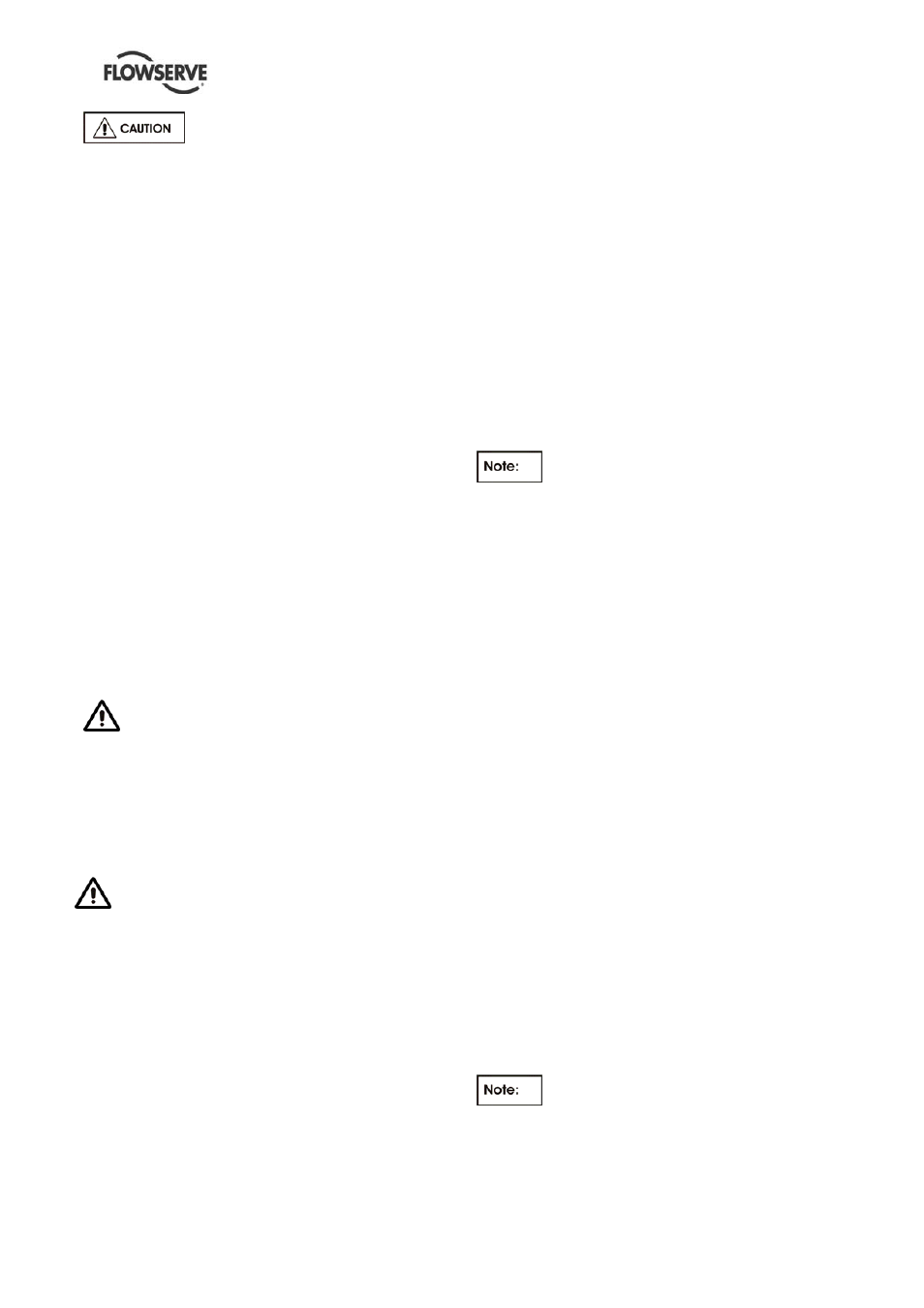Flowserve LPNV Worthington User Manual
Page 34

LPNV USER INSTRUCTIONS ENGLISH 87900031 – 06/14
Page 34 of 48
Remove the pipe plug(s) from the
top of the bearing housing(s) and check to see
that oil rings are riding free on the pump shaft
and are not hung up. Failure to observe this
caution could result in damage to or destruction
of equipment.
6.7.1 Disassembly procedure
Care must be exercised in the dismantling operation
to prevent damages to internal parts of the pump.
Lay out all parts in the same order in which they are
removed for convenience at reassembly.
Protect all machined faces against metal-to-metal
contact and corrosion.
6.7.1.1 Disassembly procedure for inspection of
thrust bearing and mechanical seal
a) Switch off, lock and tag the motor circuit
breakers. Disconnect and tag electrical leads at
motor. This operation must be done by a
qualified electrician.
b) Switch off, isolate and tag all instrumentation
and monitoring equipment.
c) Close the pump suction valve. If discharge valve
has not already been closed this must be done
prior to dismantling.
d) Drain the pump casing. This can be done by first
opening the vent connections and then opening
the drains.
e) Drain bearing housing of oil by removing the
drain plug. Remove oilers.
Use caution when draining hot oil from
bearing housing to prevent burns/injury to
personnel.
f) Disconnect and remove all vents and seal flush
pipework and allow to drain.
g) It is advisable to thoroughly drain and dry off the
foundation and soleplate before attempting any
maintenance work on the pump.
This could eliminate the risk of slipping on a
wet surface causing personal injury or
mechanical damage.
h) Remove pump monitoring equipment, auxiliary
services or any other plant or equipment that
may interfere with safe dismantling of the pump.
i)
Remove pump coupling guard.
j) Disconnect coupling spacer (Refer to coupling
instructions).
k) Loosen set screw securing pump coupling nut
and remove nut.
l) Remove pump coupling hub, using a puller.
Remove coupling key.
m) In case the pump is provided with mechanical
seal (no gland seal option): loose mechanical
seal and insert setting tab or spacer, according
to manufacturer’s instructions
n) Unscrew lock screw and remove adjusting nut
from upper end of pump shaft.
o) Unscrew grub screws and remove protecting
shield from thrust bearing assembly.
p) Remove shaft guide bushing key.
q) Remove bolts and dowels that secure thrust
bearing assembly to bracket on stationary half
casing.
r) Slip off complete thrust bearing assembly from
shaft top, or dismantle the same according to
Chapter 6.7.2)
s) According to pump provision:
-
Remove gland packing (ref. 6.7.3)
-
Remove mechanical seal assembly (ref. 6.7.4)
t) Unscrew bolts and remove bottom bearing
cover. Pay attention to falling of bearing bushing
onto soleplate.
Bearing bushing is pinned to end
cover, to prevent its rotation.
6.7.1.2 Disassembly procedure in case of overall
dismantling
In case of overall dismantling of the pump, continue
dismantling procedure of the chapter 6.7.1.1 with the
following steps:
u) Remove bolts and dowels that secure motor to
motor stand.
v) Lift motor vertically. Provide a suitable support
and lower motor on it.
w) Remove bolts and dowels that secure motor
stand to pump-bracket (integrated stand option)
or to soleplate (external stand option).
x) Lift vertically and clear away motor stand.
y) Sling and suspend vertically and independently
rotor shaft and removable casing half. Use
appropriate lifting eyes.
z) Remove dowel pins and casing stud nuts, then
break casing joint using forcing-off bolts
provided on removable casing half.
aa) Carefully move away in a horizontal direction the
removable casing half to prevent damage to
casing rings and impeller, using dedicated tools
to allow pump casing opening (rif. Chapter 6.5
and Chapter 2.3 Figure n° 2.4)
bb) Secure bottom casing ring to the impeller with
tape or wire to prevent its falling.
cc) Carefully move away in a horizontal direction the
rotor assembly to prevent damage to casing
rings, bushings and impeller.
Casing rings and throttle bushing are
pinned to stationary casing half, to prevent their
rotation.
dd)
Place rotor on “V” blocks for further
disassembly.
